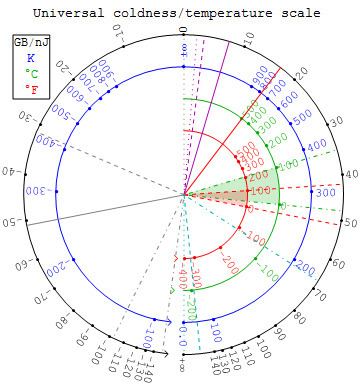 | ||
In statistical mechanics, the thermodynamic beta (or occasionally perk) is the reciprocal of the thermodynamic temperature of a system. Also referred to as coldness, it can be calculated in the microcanonical ensemble from the formula
Contents
where kB is the Boltzmann constant, S is the entropy, E is the energy, V is the volume, N is the particle number, and T is the absolute temperature. It has units reciprocal to that of energy; in units where kB=1 it also has units reciprocal to that of temperature. Thermodynamic beta is essentially the connection between the information theoretic/statistical interpretation of a physical system through its entropy and the thermodynamics associated with its energy. It expresses the response of entropy to an increase in energy. If a system is challenged with a small amount of energy, then β describes the amount by which the system will "perk up," i.e. randomize. Though completely equivalent in conceptual content to temperature, β is generally considered a more fundamental quantity than temperature owing to the phenomenon of negative temperature, in which β is continuous as it crosses zero whereas T has a singularity.
Statistical interpretation
From the statistical point of view, β is a numerical quantity relating two macroscopic systems in equilibrium. The exact formulation is as follows. Consider two systems, 1 and 2, in thermal contact, with respective energies E1 and E2. We assume E1 + E2 = some constant E. The number of microstates of each system will be denoted by Ω1 and Ω2. Under our assumptions Ωi depends only on Ei. Thus the number of microstates for the combined system is
We will derive β from the fundamental assumption of statistical mechanics:
When the combined system reaches equilibrium, the number Ω is maximized.(In other words, the system naturally seeks the maximum number of microstates.) Therefore, at equilibrium,
But E1 + E2 = E implies
So
i.e.
The above relation motivates a definition of β:
Connection of statistical view with thermodynamic view
When two systems are in equilibrium, they have the same thermodynamic temperature T. Thus intuitively, one would expect β (as defined via microstates) to be related to T in some way. This link is provided by Boltzmann's fundamental assumption written as
where kB is the Boltzmann constant and S is the classical thermodynamic entropy. So
Substituting into the definition of β gives
Comparing with the thermodynamic formula
we have
where
